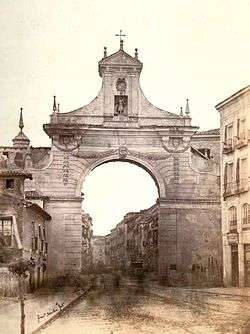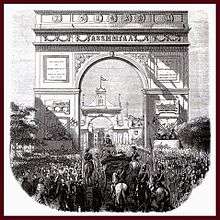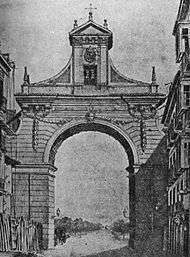Puerta del Campo

Puerta del Campo, also called Arco de Santiago, was a City Gate in Valladolid (in Castile and León, Spain). Located in the streets of Santiago, where meets the current de Doctrinos, then de la Boariza, and Claudio Moyano, in other times Alfareros, was named as del Campo the street that accessed; but at the same time, its presence marked all over surrounding. At least until 18th century, the whole Campo Grande surrounding was known by the generic name of "Puerta del Campo, outside Puerta del Campo, etc ...".
History
The gate stood there in the first third of 14th century, when the second City Walls reaches this latitude on the southside. The first record of its existence comes from the Chronicle of Alfonso XI, which mentions the Gate and the Bridge del Campo. To it came all south's roads and through it went out from city by calle de Santiago, growing importance road in urban life and was then divided into two sections with different denomination: "Santiago", from Plaza Mayor to junction with calle de Zúñiga and "del Campo", from the calle de Zúñiga to this gate.
The gate was the true limit of the city and also had a defensive character. This gate along that in Main bridge (Puente Mayor), were the two main of the city, which is justified by its immediate situation to the road to Madrid. This circumstance determined that since the turn of the 16th century play a fundamental activity as place of receipt of illustrious people. By this time there were already several buildings outside the City Walls, as well as a public fountain. Over time, the Gate lost its character as a barrier, city limit, to be reduced to an important honorary and decoration role.
It is likely that the first battlement and turreted gate was maintained until the mid-16th century. At that time was a reform in the area and also reached the gate. Could be a purely urban remodeling for the place, which would provided with a greater range, or perhaps was an architectural transformation of the gate self, then it lose its medieval defensive aspect. As reported a corregidor in second half of 16th century, there was no longer tower in the City Walls.

No more was known about the gate until 1565, at which time, due to passing by Valladolid by Queen Elisabeth of Valois, Philip II, way to France to meet with her mother Catherine de Medici, the city made major entertainments among which highlighted adornment and decoration to Puerta del Campo, place where the official reception in the city was made as was usual. This time the works were important from the decorative point of view, reaching a great interest of Juan de Juni in the participation in it. The Puerta del Campo's decorative arch, was not an arch built of new plant, but other materials with which it is overlaid on both faces, plus adding a body of height and two side aisles framing its south facade, looking at Campo Grande. The architecture would, according to Martín González "Escorial inspiration's lines, with use of pyramids and balls." The entire set was covered with paintings arranged on the empties for destined to them either on the walls, work of painters Benito Rabuyate, Mateo Espinosa and Antonio de Ávila. The paintings in addition to representing the Kings and other members of the Royal family, represented mythological themes, allegorical and even alluding to the city. The queen made her entrance into the city on May 3 of that year 1565. There are numerous reports of this event. One of them says that "the 42 side windows of an arc that stood on the gate Puerta del Campo were populated with musicians who to pass the Queen tolled all harps, arc lyre, flutes and many other instruments." Past the celebrations the arc not was immediately dismounted, in May 16 formed a committee "to make and sell the canvases and remains of the arch of the Puerta del Campo", but on July 2, still gave the order "to be sold the paintings are in Puerta del Campo in the arch of it, and the nails and wood of that arch."[1]
More than twenty years later, in 1589, again were news about the gate by similar reason. This time Philip II was expected to visit the city, and between entertainments and enhancements that set out agreed "that the Puerta del Campo mindful garnish of the shot and roof of it is very ugly and make a better shot as better seem Diego de Praves, master of the greatest works of this city." In 1592, before the trip of Philip II self, that was the last to do in Valladolid, was commanded to dressing again the Puerta del Campo and "remove the placards that have and put other and paint." At this time appears the gate with the dedication that will henceforth and will feature the Puerta del Campo, to serve as a decorative element, triumphal arch and large "poster" that decorates and again with paintings and legends alluding to the glories of the reigning monarch.
For the history of the Puerta del Campo was very important the first third of 17th century. Some local historians states the gate disappeared when ceased to have effect the second City Walls of the city, being replaced by the Arco de Santiago, erected in its place, in 1626, by Francisco de Praves. In May 1628 formed a committee "to dress and repair the arch and turret of Puerta del Campo". Repairs should be of minor importance because in September were finished, but in November 20 is entrusted to Francisco de Praves, regidor of the city since that same year "that grop what might cost to make two sculptures and put them to are with all decency and ornate in the Arch of the Puerta del Campo, one to del Campo, and the other to the street of it, and that must be one of the Resurrection of Our Lord and the other of Our Lady of Conception". There is no evidence that these sculptures could materialize, but the record is of interest because it is the only time that documents the name of Francisco de Praves joined the Arch. It also states that since at this date the Arch should the disposal that after keep with its reserved place to place sculptures on its both facades.
In 1655 was decided to decorate the arch by two paintings with portraits of Our Lady of Saint Lawrence and Saint Michael Archangel, which will be finished on April 3, 1656. Since that time, the images of the Virgin of Saint Lawrence and Michael Archangel would be permanent guards and ornates of the arch -now on canvas, later sculptures until its demolition. It is quite possible that the paintings occupy the same arrangement then had the sculptures on the attic of the building, the Virgin on the north facade and the Archangel on the south, facing calle del Campo.
During following decades were placed along the arch different portraits of monarchs who were reigning. For example, in 1690 painted the portraits of Charles II and his wife Maria Anna of Neuburg, which were replaced in 1707 by equestrian portraits of Philip V and Maria Luisa of Savoy.
The appearance that the Arch had during 18th century had two graphic witnesses due to artist and engraver Diego Pérez Martínez, dating to 1759 the first and then 1788 the second. The appearance of the Arch in one and another drawing differs in fundamental lines of its architecture, but in its decoration. In the first the arch is profusely decorated with trimmed plates and abundant Baroque style's reliefs and plasterworks. On the keystone of the arch figure a kind of mask, adorned with wreaths will be retained although slightly modified. The attic, flanked with balusters, large buttresses and pyramids, and topped with a pediment decorated with a stucco, houses a sculpture, that of Saint Michael. The second picture shows that arch decoration was much more severe, persisting some ornaments of plates recessed in the first section of the pilasters. The garland adorning its keystone and leans is the same that will be maintained until the arc is tear down. There is no doubt that between both dates the Arch underwent a reform that adjusted its appearance in the new Neoclassical currents, without knowing the year that took place, although it could well be in 1774, when the city's foreman, Francisco Pellón, recognized the Arch by mandate of the corregidor. During the rest of 18th century occurred repairs, and in 19th century the emphasis of work varies, as it become less frequent but more complete.

In 1858, on occasion of the visit of Isabel II and the royal family in Valladolid, is stucco the Arch, which besides was decorated with shields and inscriptions depicting glorious sons of Valladolid and the Spanish monarchs who had taken the name of Alfonso. In 1861 Isabel II would make a new visit, this being perhaps the last time the arch was decorated to celebrate such an event. Its location just off calle de Santiago, where traffic had increased significantly, especially after the opening of the railway, and the fact that the Arch to adjacent walls covering the entire width of the street and reducing the pass just to its light, would be the cause of its demolition. In addition, it studed at that time a new alignment of the streets in this area -concretely Alfareros-, and within it was considering the demolition of the Arch.[2]

In first months of 1864, a new cry out for the tear down is made, saying that "There is nothing more detestable and look worse than this renowned monument." In June approved its demolition and conditions of it.[3]
The problem of the sculptures installed in the chapel of the Arch was solved by a communication from the City Council to the Archbishop to take charge of them. Archbishop commissioned of it to the Parson of Santiago. The sculpture of the Virgin that had to be small, nothing it know. García-Valladolid says that conserved a particular. As for the Archangel Michael, the same chronicler reports that was installed in the church of Santiago, in the chapel of the Baptistery. In 2013 was changed of location, being now located in the choir, but viewed from the nave of the church. where this is today. Finally, on August 29, 1864, began the demolition of the Arch and on September 14 ended.